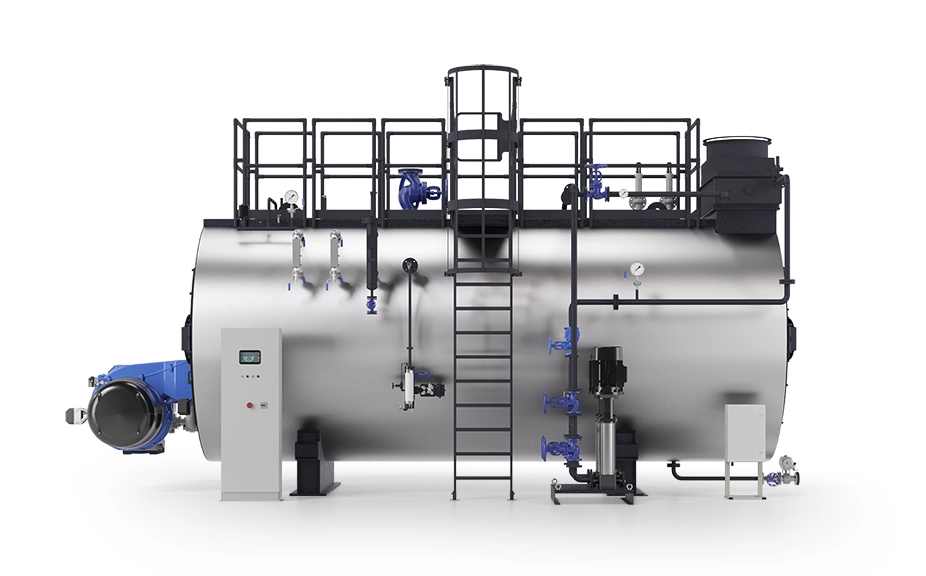What’s an industrial steam boiler?
In order to be able to choose from among the various machines available, one must first understand how they’re built and how they work.
Let’s start with the basics.
steam boilers are generally made up of 2 main components: the burner and the boiler body.
The boiler body itself is made up of a combustion chamber and tube bundles, which follow various pathways depending on the applications.
Depending on whether combustion flue gas or water flows through these tube bundles, the unit is classified as either a fire tube or water tube steam boiler.
In addition to these two categories, there are also many others, which even include smaller products for domestic use.
This article will discuss steam boilers for industrial use, which are extensively used for a wide range of applications in production lines all around the world.
Table of Contents:
- The main parameters for choosing a steam boiler
a. Steam flow rate and maximum available pressure;
b. Efficiency, in terms of electricity and natural gas consumption;
c. System emissions;
d. Daily management and maintenance;
e. Water treatment. - Conclusions
1. The main parameters for choosing a steam boiler
In an effort to provide more specific numerical indications, we have examined various cases in which fire tube steam boilers are utilized, given their widespread use throughout the industrial world.
As previously mentioned, steam boilers are comprised of a burner and a boiler body.

The burner is inserted into the combustion chamber and controls the flame, where hot flue gas travels through the boiler body’s tube bundles in order to heat the surrounding water.
The pathways of the tube bundles vary depending on the application, providing different performance levels.
Now then, let’s take a look at the main parameters to take into consideration when choosing a steam boiler.
The most important are the following:
- Steam flow rate and maximum available pressure;
- Efficiency, in terms of electricity and natural gas consumption;
- System emissions;
- Daily management and maintenance;
- Water treatment.
a. Steam flow rate and maximum available pressure
Let’s begin with the most simple and trivial technical characteristics.
Based on your production plant’s needs, you will likely have already determined its daily steam requirements in terms of both pressure and flow rate.
Starting with these values, and adding a safety margin (20-30% is recommended), we can obtain the necessary flow rate and pressure values.
Each boiler model taken into consideration must comply with these parameters.
The calculation of the pressure values and flow rates required of the steam boiler becomes increasingly crucial as the system’s complexity increases.
In fact, while the steam flow rate and pressure value calculation are rather simple for a small dairy that only uses steam for pasteurization, it becomes more complex when other needs have to be met, like heating ovens, humidification, and system sterilization.

b. Steam boiler consumption
Together with the initial cost of a new system, it’s operating and maintenance costs are certainly the second most important aspect.
In order to clarify what this means, we studied a number of our steam boilers used by different companies for various applications over the course of 10 years.
We added up all the costs incurred over that 10-year period for the initial purchase, installation, natural gas and electricity consumption, and maintenance interventions.
The analysis showed that the boiler’s initial cost was less than 10% of the entire cost of the system (a figure that grew progressively smaller the longer the system was in service).
The majority of the costs were due to natural gas and electricity consumption and maintenance.

This reveals why it is so important to decrease these cost items as much as possible.
Let’s begin with the largest items, or rather the cost of natural gas and electricity.
In order to estimate electricity consumption, it is necessary to analyze the installed power, normally expressed in kilowatts (kW), and to multiply it by the estimated time of use, and, finally, the average cost per kW/h.
This would be the case if we were to hypothesize the boiler’s constant use at maximum power, so the data must then be broken down based on the boiler’s actual everyday use.
When calculating natural gas consumption, on the other hand, it is best to start with the desired steam output, for example, 1 tonne per hour.
Knowing the boiler’s efficiency and the heat needed to bring the water to a temperature of 80 degrees with steam at 10 bar, we can calculate the total amount of heat necessary, and therefore the amount of gas necessary.
![]()
As you can see from the simplified formula, the boiler’s efficiency plays a fundamental role.
For the sake of simplicity, we have calculated the volume of natural gas necessary hypothesizing the boiler’s use at 100%.
However, steam boilers often operate at variable outputs, depending on the load required.
The efficiency values shown on the technical data sheets refer to maximum load conditions, but they change progressively based on the output dispensed.
The daily and seasonal load conditions must, therefore, be taken into consideration when evaluating the boiler’s efficiency.

If the steam requirements vary significantly within the span of 24h, it becomes important to have a modulating burner capable of adapting to the various conditions, while at the same time maintaining good efficiency.
In short: Electricity and natural gas consumption are two important cost items.
For each of these two items, calculate how much the new system can make you save, and how. Afterward, compare the data of the various manufacturers, and choose the model that guarantees you the best-operating conditions, and therefore savings, for your daily use.
c. Steam boiler emissions
A third aspect that’s becoming increasingly important is atmospheric gas emission limits.
Much like cars, boilers are also subject to increasingly strict regulations in terms of emissions.
And in this case, as well, the problematic gas types are nitrogen oxides (NOx).
The limits, which were previously broken down based on the region of provenance, have now been unified under a single nationwide limit of 100 mg/Nm^3.
This limit only refers to industrial thermal systems and does not retroactively apply to previously installed boilers.
And while this is the Italian limit, it should be kept in mind that the various countries around the world have even more restrictive limitations due to the harmfulness of these gases.
California and China, for example, will impose maximum limits of 25-30 mg/Nm^3 in the coming years.
The limits that China and California have imposed upon themselves are derived from the technologies currently available on the market.
Given the products present on the market, anyone looking for a new steam boiler should certainly take emissions into account, in order to protect the environment as much as possible.
d. Daily management and maintenance
Once the boiler has been chosen and installed, the “problem” of its daily management arises.
As you certainly already know, steam boilers are pressurised machines that require constant supervision.
This supervision must be provided by an operator who has received specialized training on the boiler’s management.
One way to decrease the operator’s workload is to have the boiler certified for continuous unsupervised operation for 72h.
Another way to simplify the daily management of a heating plant room is through the use of connectivity.
In fact, many boilers are equipped with numerous sensors to monitor their performance parameters, and these can be sent to a remote server via an Internet connection, where they can be independently viewed by the system’s manager.
And if this aspect is combined with the possibility of controlling these parameters remotely, the time required for daily management decreases even further.
But in addition to the boiler’s daily management, maintenance must also be taken into consideration.

And while it’s difficult to come up with a precise estimate of the maintenance costs, you can, however, get a general idea.
For example, some companies offer ordinary service contracts for new boilers, while other local service centers offer practical spare parts kits to be kept on hand.
It is also recommended to check the origins of any pumps, sensors, and valves, and to only choose those from reliable and well-known manufacturers.
In terms of both ordinary management and maintenance, having an electronic control system connected to the Internet certainly facilitates work activities.
Once again, be sure to check that the new boiler is connected to the Internet and that the manufacturer can even provide support remotely by directly accessing the boiler’s controls.
This facilitates the interactions between the 2 parties’ technicians and limits the intervention time necessary to resolve any problems.
e. Water treatment
One last important aspect regards the treatment of the water.
In fact, it’s important to continuously monitor the water’s parameters and to ensure that they are consistent with those required by the manufacturer.
The water must be devoid of salinity to avoid scale build-ups, dissolved gases to eliminate the risk of corrosion, and organic substances to prevent the formation of foam and deposits.
The less salinity and dissolved gases present in the water, the longer the boiler will remain in function and the less maintenance will be required.
Every steam boiler manufacturer installs different water filtering and blowdown systems.
Specific information must be requested in this regard during the purchasing phase in order to ensure that these systems constantly monitor the water, prevent needless waste, and, if possible, are connected to the Internet.
Waste is most likely to occur via the blowdown systems.
In fact, these systems eliminate the water from the boiler body in order to allow any salt deposits on the surfaces and the bottom to be removed.
In doing so, the blowdown systems discharge numerous liters of water that has already been treated and, above all, has already been heated.
This naturally has an impact on the system’s overall efficiency.
It is therefore recommended to check the types of blowdown systems that are utilized and the amount of water that is eliminated every day in order to determine which system wastes the least.
Conclusions
In this article, we examined the most important parameters to be taken into consideration when purchasing a new boiler.
Let’s go over them once again briefly.
It is first necessary to evaluate the production system’s daily and seasonal requirements in terms of both steam flow rate and pressure.
In order to improve the system’s efficiency, it is necessary to calculate requirement curves that are as accurate as possible.
The most suitable boiler can be chosen based on the trends.
When choosing a boiler, it’s important to keep in mind that the initial investment (purchase cost) only represents a small portion of the overall costs that will be incurred throughout its lifetime.
In fact, the greatest savings can be obtained by taking the boiler’s entire lifespan into account.
In the end, the best efficiency and savings can be obtained by considering the electricity and natural gas consumption parameters, as well as the daily management and maintenance costs.
While a certain system, valve, pump, or burner may seem somewhat costly, it could provide for slightly better efficiency, which, over the long-term, translates into continuous savings.
